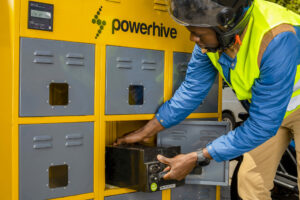Between drought, forest fires, and mudslides and what-not, California seems to be one big ball of problems these days. One of those problems in the what-not category is access to offshore wind power. The Pacific coast is teeming with renewable energy potential, but the water is too deep for conventional offshore wind turbines. The Golden State is missing out on thousands of new jobs and bundles of economic activity, except maybe not, if all goes according to plan in France.
Offshore Wind Power: France To The Rescue
The offshore wind technology that can conquer deep waters is a simple platform that enables wind turbines to float on the surface instead of having to be fixed into the seabed. Of course, the devil is in the details, including the challenges posed by stormy seas and saltwater corrosion as well as the little matter of transferring all those clean kilowatts from an offshore location onto shore, in addition to fighting off objections from other marine stakeholders.
So, it’s not that simple. The floating offshore wind turbine industry has been baby-stepping its way into the global clean power portfolio, but activity has been picking up rapidly in the past few years. Among the recent projects is the proposed Les Éoliennes Flottantes du Golfe de Lion (EFGL) floating offshore wind farm hosted by France.
The 30-megawatt project will sport three 10-megawatt turbines planned for a site in the Natural Park of the Gulf of Lion about 16 kilometers from the coast of Leucate and Le Barcares in the French Mediterranean.
The new wind farm also represents a strategy for working around objections from the fishing industry, as it is located in a marine reserve.
Floating Offshore Wind Power Finally Gets Its Moment
It’s a good bet that wind stakeholders in California are taking notice of the EFGL project. The company behind the floating platforms for the new wind farm is Principle Power, a firm that first crossed the CleanTechnica radar back in 2009 with an experimental floating wind project supported by the US Department of Energy.
By 2014 Principle Power was demonstrating its floating wind power technology off the coast of Oregon, again with the support of the US Department of Energy, and the company has continued to help shepherd the floating wind industry along here in the US.
All that activity put the US in the pole position to lead the world in floating wind technology. Too bad certain state and federal policy makers (you know who you are) missed the boat on creating new jobs in the US offshore wind industry, but that gave France an opportunity to take advantage of lessons learned while Principle Power fine tuned its technology.
“EFGL will see the deployment of the 3rd generation of WindFloat® technology, which builds on lessons learned from previous projects and includes important innovations in modularization and manufacturability to further increase deliverability and competitiveness,” Principle Power enthuses.
More Offshore Jobs — For France
The EFGL project could have huge implications for the entire US wind industry. Floating or not, offshore wind has been slow to take off in the US even while other nations have leaped ahead. The EFGL project will demonstrate how offshore wind fits into the energy transition, economic development, and nature conservation picture.
According to Principle Power, the project will create almost 400 direct and indirect long term jobs. An additional 100 or so manufacturing jobs will be created during the construction process, which will be housed in a facility that had been previously targeted for oil and gas infrastructure.
As indicated by its location in a nature preserve, the new offshore wind farm will feature a number of modifications aimed at promoting biodiversity while discouraging invasive species.
Among those is an artificial fish habitat developed by the firm Ecoocean, to be installed on one of the floating platforms. Called Biohut, the habitat has already been tested on an observation buoy in the marine park.
“Researchers observed a real increase in the biodiversity of species in and around BOB and, importantly, no invasive species were observed on the structure,” Principle Power explains, adding that “This project is very important for us because the WindFloat® technology used will be a little different than what we did previously. We have optimized the structure thanks to the experience we have acquired.”
Next Steps For Floating Offshore Wind, In California…& Maine?
It looks like the EFGL project is on track to commence operations in 2023. Meanwhile, Principle Power is ramping things up a notch.
A new 270-megawatt offshore wind project is taking shape in South Brittany, and among those in the running to develop it is Ocean Winds, a mashup of the well known firms ENGIE and EDP Renewables. Last week, Ocean Winds announced that it will be collaborating with Principle Power to design the floating turbine platforms.
That’s peanuts compared to California’s offshore wind power potential, which easily soars into the gigawatt scale.
For that matter, California needs to pick up the pace if it wants to lay claim to the first floating offshore wind farm in the US. Little old Maine could beat California to the punch. A few years back, the Pine Tree State was hot on the track of new floating wind technology that could enable it to plumb its rough coastline for offshore wind power, only to be sidetracked by politics. Now it appears that the project is back on track.
More Green Jobs For The US, But Who’s Going To Work Them?
Circling back around to California and all those gigawatts of clean power, last year the organization American Jobs Project released a report anticipating that the overall job-creating potential of the California offshore wind industry adds up to about 17,500 direct and indirect jobs.
That’s only based on a conservative estimate of installing 18 gigawatts in offshore wind capacity by 2045. The state actually boasts a technical potential of 112 gigawatts. Many of those extra gigawatts are far out of reach, but others could be up for grabs.
In an interesting twist, oil and gas developers could speed things along in the offshore area by leveraging their offshore knowledge base and investment muscle.
The cost of floating offshore wind remains an obstacle, but fans of the technology point out that wind speeds are more optimal farther offshore, raising the potential for squeezing maximum efficiency out of each turbine.
Another question yet to be settled is who’s going to work all those new green jobs. After all, we’re in the middle of a profound labor shortage. Millions of US workers quit their jobs during the pandemic and many dropped out of the workforce entirely to care for children and other family members.
More support for child care, family care, education and job training would help, so keep an eye on that Build Back Better bill floating around Congress.
Follow me on Twitter @TinaMCasey.
Photo: Floating offshore turbines via Ocean Winds.
Appreciate CleanTechnica’s originality? Consider becoming a CleanTechnica Member, Supporter, Technician, or Ambassador — or a patron on Patreon.

- 100
- access
- Additional
- ADvantage
- Advertise
- All
- American
- among
- announced
- AREA
- around
- Bill
- build
- california
- Capacity
- care
- child
- Children
- cleantech
- Cleantech Talk
- company
- Congress
- construction
- corrosion
- Creating
- Department of Energy
- Design
- develop
- developers
- Development
- DID
- dropped
- Economic
- Education
- efficiency
- energy
- experience
- eye
- Facility
- family
- farm
- Feature
- Federal
- Finally
- fine
- Firm
- First
- France
- French
- GAS
- Global
- good
- Green
- Guest
- here
- How
- HTTPS
- huge
- Including
- Increase
- industry
- Infrastructure
- investment
- IT
- Job
- Jobs
- knowledge
- labor
- lead
- learned
- Lessons Learned
- location
- Long
- Maine
- manufacturing
- Members
- ocean
- Offshore Wind Turbines
- Oil
- Oil and Gas
- Operations
- Opportunity
- Oregon
- organization
- Other
- Others
- Pacific
- pandemic
- Patreon
- picture
- platform
- Platforms
- podcast
- policy
- politics
- portfolio
- power
- project
- projects
- punch
- radar
- renewable energy
- Renewables
- report
- running
- Scale
- Simple
- So
- South
- speed
- Sport
- State
- Strategy
- support
- Supported
- Surface
- Technical
- Technology
- the world
- track
- Training
- turbine
- twist
- us
- Water
- week
- WHO
- wind
- wind power
- wind turbine
- Work
- workers
- Workforce
- world
- year
- years







